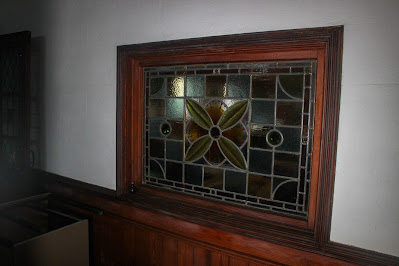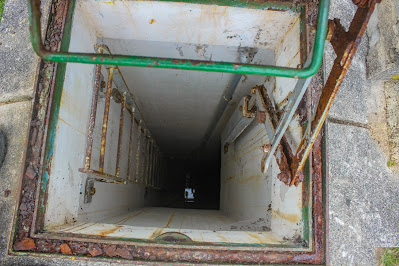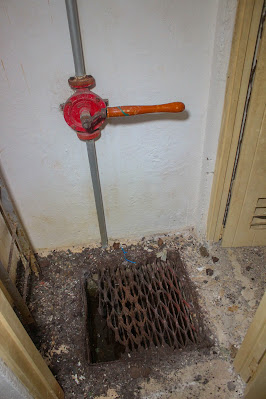While we were mooching about in Wales, we spotted this chapel completely accidentally, and naturally we couldn't ignore it. Look at this thing! It's gorgeous but unloved and a total wreck, just like me.
The words at the top of the chapel read "Maes Y Neuadd" which translates to "the hall in the field." The words underneath it translate to "independent place of worship," meaning that this place was non-denominational. I'm still not entirely sure what that means. Denominations are like the fracturing of one religion into literally thousands of variations, all believing that their way is the real way to practice the "one true religion," so surely by rejecting all denominations to be independent of them creates a denomination in itself? To me it makes no sense, but hey-ho.
I wasn't expecting there to be quite an extensive story behind this one, but it turns out that "Maes Y Neuadd" was actually the name of a farm where a young Welsh woman, Sidney, lived with her dad. One day, while on a visit to Caernarfon, she heard a preacher do a church service and she was so captivated by it that she came home and basically asked her dad if she could set up a chapel in their home.
He agreed, which baffles me a little bit. I'm all for parents encouraging their children's ambitions, but there are limits, and usually that limit is somewhere before grabbing a bunch of people and doing religious ceremonies in their house. Nevertheless Sidney started doing just that, with seven members of the locality being founding members of her new church. Up until then they had been walking to another chapel in a 25-mile round trip every Sunday, so this little farm shindig must have been really convenient. Among them was Owen Jones who Sidney would go on to marry. The couple would inherit the farm and continue using it as a chapel for the next eighteen years. But they realised the impracticality of having their growing flock coming over to the house every Sunday. What they needed was a real chapel, and so they set out to get one.
Well they didn't get this one straight away. There's another former chapel just down the road, and if I had known it would be a factor in the story I would have photographed that too. I guess I'll have to nick a shot from Streetview.
(Photo taken from streetview)
The sign on the side says it was established in 1863, but other sources say a chapel was on this spot as early as 1812. The conflicting dates annoy me a bit, but perhaps it was modified or even rebuilt entirely at some point.
It was built on land obtained by a rich woman who I only know as Mrs Edwards. Her husband was down in Portsmouth where he became seriously unwell. Being a Welsh speaker, everyone down there just thought he was weird. The only person who attempted to comfort him as his illness progressed was an independent minister who would visit him and read to him until the end of his life. Mrs Edwards was so moved by this kindness that she was quickly won over to non-denominational church practices and happily went about sinking some money into some land for Sidney Jones chapel.
She purchased some land. The former owner didn't really want a chapel being built there, but she told him that it was to build a home for a master and their servant. The landowner thought this proposition was referring to Mrs Edwards herself and her servant, so he sold the land to her. He was a bit miffed when she did have a chapel built on it, but she pointed out that she hadn't technically lied. This was Gods house, and she was the servant.
Sneaky!
And so the first chapel opened. It had its own name, but the congregation continued calling it Maes Y Neuadd anyway, after the farm house where they'd been meeting for years prior. But with a nearby quarry causing the village population to swell, by the late 1800s the chapel was not fit for purpose, and so in 1874 a second chapel was built, this time on the site of the one I'm exploring today.
I'll include a photo of it below.
(Photo not mine, obviously)
Initially they sought to extend the chapel that already existed. However they found that they were met with resistance from the landowner, who was no longer the lovely but deceased Mrs Edwards. However the farm across the road was owned by the sister-in-law of one of the church members, so using that connection they were able to build this chapel almost directly across the road from the original one.
With the population ever growing due to the quarry, and with most of the workers coming over from England, the original chapel was set aside for them, while this one was used by the locals. Old Ordnance Survey maps reflect this by referring to one as the English chapel and the other as the Welsh.
But ultimately the chapel was too small, and in 1906 it was demolished, only to be replaced by the one that stands here today, extending the capacity from about 500 to 950. As far as legacies go, it's quite spectacular that this all started with a farm girl who wanted to run a chapel from her house. My primary source of information, a publication from 1874, marvels about the new chapel being opened "last week" and claims that Sidney Jones is a household name and a hero to the locality. That makes it kinda sad to see it derelict today.
The doors were wide open, but as you can see, the place is falling to pieces.
Much to our surprise, and somewhat disappointment, the chapel was full of clutter. It looks like someone has been using it for storage purposes. Nevertheless, it's still possible to appreciate the architecture.
There are loads of old photos of this place online, albeit they are photos of photos. Someone somewhere has a physical album but no scanner, so just took photos of them. It means the quality is a little naff, and the images aren't straight, but neither was Jesus so it's okay. The photos really help bring some character to the place. It's one thing to see a derelict building, but it's another thing to see that derelict building still in use decades earlier.
Here's an old nativity play from 1956. Some of these children are still alive today, albeit considerably more arthritic and wrinkled.
There's a tiny dead bird in one of the windows. Perhaps it tried to fly through it and whacked its head.
Here we are facing the pews from the pulpit. This is the view that the preacher would have had back in the day, albeit with less mess.
And thanks to vintage photos, we can see how it looked when it was full of pensioners.
This photo is from the 1960s pensioners dinner, and I would be very surprised if any of these people are still alive. But they are all remembered by people who are still alive today. Everyone here was someones parent, grandparent, uncle, aunt, or neighbour.
Let's check out the support columns.
These are what really drew my attention. I don't think they're actually made of marble, but they still look pretty cool.
I've found a few shots from 1957 of people sat in the pews in front of this window What puzzles me is that the occasion is said to be the chapels centenary, which makes no sense and conflicts with the dates that I've found. Granted, my source in this case is a little less reliable. Here in he latter half of the 20th Century I'm relying on old peoples childhood memories. They're great, but they aren't as accurate as a written document from the era.
(Photo not mine, obviously)
It's always interesting to breath life into a derelict place by showing it still in use by actual people, but I can go one step further and actually put names to some of these faces, and even nicknames, keeping in mind that my sources come from people who were children when this photo was taken. On the bottom right corner is Gwyn Jones the minister, and second from the left on the bottom row is apparently a "Mr Parry" who the local kids were scared of.
Second from the right on the third row is a chap called Huw, who was nicknamed "Mochyn Bach," which is pretty funny given that it translates to "Little Pig." But then on the back row is a chap whose unflattering nickname was "Handbag," because he used to carry a bag when he collected peoples rent.
Also present is a chap nicknamed "Tommy Bach Mawr," an odd nickname considering "Bach" means Small and "Mawr" means big. Apparently as a child his nickname was "Little Tommy," but then he had a horrific growth spurt, and his nickname just evolved. He was known for his eccentric ties and his bizarre sense of humour. One time during a haircut he suddenly started screaming that he was being murdered.
I actually love that. It's one thing to look at black and white photos of long dead people, but to hear the nicknames that children gave them, and to hear anecdotes about their quirks, it adds a whole new dimension. It's a good dose of humanity that brings these people to life.
Also present is a "William Owen," the
last to person to leave Nant Gwrtheyrn, a quarry village that dispersed in the
1960s when the quarry closed. He lost his daughter in a motorbike accident and his wife is said to have hit the bottle after that. William Owen allegedly once caught a fox in a sack and decided to bring it to show everyone. The fox got free and bit him on the hand, so he grabbed it by the back legs and swung its head against a wall until it died.
Hmm. I'm no expert on foxes, but it seems to me that if you don't want to be bitten by one, it's probably best not to catch them in sacks.
Keep in mind my sources are alive today but were children then. He did that in front of children!
Speaking of which...
(Photo not mine, obviously)
Here we have the children of the congregation. Apparently the reason why some of them look terrified is because in order to get them to sit still, they were told that a missionary named Tamate lived in the attic and was watching them to make sure that they didn't sin.
And that's amazing. Forget about Hell and the threat of eternal damnation. Every church needs a weird attic man.
But what really blew my mind is that Tamate was a real man! His real name was James Chalmers, and he was born in Scotland in 1841. He became a missionary, and was sent to the South Pacific island of Rarotonga in 1867 where they nicknamed him Tamate. He was initially disappointed to find that
the island already had Christianity and didn't really need converting, but he soon got busy breaking up drunk
brawls and "redirecting the natives energy to wiser practices." He
produced a magazine and became super popular before dying in 1901.
How the Hell did a Scottish missionary in the South Pacific go on to become some boogeyman figure in rural Wales a hundred years later? That's probably the most bonkers legacy ever. I love it.
Here's a closer look at the stained glass window behind all of those vintage group shots.
The clutter in the chapel didn't really interest me that much, but I did like this collection of Welsh bibles.
There's a couple of memorial signs here. One is for Mr and Mrs Jones who let their home be used as the chapel in 1971. I wonder what the reason could have been. Perhaps the chapel needed some work.
The other memorial states that the chapels main ceiling lamp was donated in 1935 by Mrs Roberts to honour her deceased husband who was the deacon for 35 years. That's quite touching. It's like even though he's gone, something of his is still here.
Next to the pulpit is the old hymn board. I don't think I've ever seen one of these in a derelict chapel before.
I've also found an old photo of the minister, Gwyn Jones, standing at the pulpit.
And there, open in front of him, is a great big bible. And it's still here!
This book is seriously huge.
I'm not religious, but I think the bibles alright if people don't take it literally. It's a collection of some fun metaphorical stories, sometimes about love, sometimes about genocide. The bible isn't the problem so much as the weird people who think Dinosaurs didn't exist, and use bits of this book to justify behaving like a total wazzock. This particular bible is illustrated, which is kinda cool.
And it's entirely in Welsh.
So in 1941, the Germans were dropping bombs on the English cities, and many children were evacuated to remote parts of the countryside. This village is pretty damn remote, and so it became the temporary home for a horde of Liverpool children, and their teachers.
The evacuees were apparently taught in the vestry of this chapel, separated from the Welsh students. Although given their total immersion in rural Wales, most of them did learn Welsh by the time they were allowed to go home.
And that's pretty cool!
The vestry is the room at the back of the chapel. Let's go check it out!
Oh. It sure is clean! It suddenly hit me that even though the chapel itself was derelict and disused, services were still being held in this part of the building. It's not as abandoned as the exterior appearance had me believe.
Whoopsie!
So I guess this really counts as a fun mooch more so than urbex. Presumably someone is gathering funds to restore the damaged chapel and bring it back to working order, and they're just taking temporary measures here in the back room for the time being. I guess we should call it a day. It is pretty cool that this all started from a young farm girl wanting to run a church from her home.
My next post will be on my local blog. I'm going to start tying up some loose ends in my local area by focusing on all the little things nearby that I've previously given a miss in favour of the awesome places here on the travel blog. Having said that, the blog after next is a pub on the travel blog. But it's pretty awesome.
If you like my blogs and want regular updates... well Zuckerberg is pinching my social media reach more and more every day, but in theory you should be able to see my updates if you follow me on Instagram, Facebook, Threads and Twitter. I'm also active on Vero and Reddit. Vero has a smaller userbase but algorithmically it's everything Instagram should be. And Reddit's Reddit.
Thanks for reading!





























































































